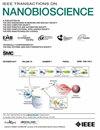用于表面增强相干反斯托克斯拉曼散射的超小型片上实验室设备。
IF 3.7
4区 生物学
Q1 BIOCHEMICAL RESEARCH METHODS
引用次数: 0
摘要
本文介绍了一种用于表面增强相干反斯托克斯拉曼散射的超小型片上实验室设备,其尺寸为 8 × 0.8 μm2。该装置包括一个独特的混合质子光子垂直耦合器(用于装置与光源之间的光耦合)和一个七聚体质子纳米镊子(用于捕获和操纵纳米粒子)。耦合器的纳米尺寸为 0.73 × 0.8 μm2,在 ~ 1 - 1.13 μm 波长范围内的最大耦合效率和指向性分别为 -4.2 dB 和 17.8 dB,带宽为 3 dB。基于有限元法的理论表明,基于泪滴的纳米镊子可使器件产生≥ 1017 的超高拉曼增益,从而使单分子水平的探测成为可能。通过使用能量较低的光子的近红外波长范围,拟议的装置对生物颗粒的损害较小。由于光路较短,该设备有望通过降低背景相干拉曼信号的水平来提高拉曼信噪比。最后,得益于其配置,该设备可以创建并行测量通道,为开发高通量和批量生产的生物传感器铺平道路。本文章由计算机程序翻译,如有差异,请以英文原文为准。
Ultracompact Lab-on-a-Chip Device for Surface-Enhanced Coherent Anti-Stokes Raman Scattering
This paper introduces an ultracompact lab-on-a-chip device with a size of
$8\times 0.8~\mu \text{m}^{\mathrm{ 2}}$
for surface-enhanced coherent anti-Stokes Raman scattering. This device comprises of a unique hybrid plasmonic-photonic vertical coupler, for light-coupling between the device and a light source, and a heptamer plasmonic nanotweezer for trapping and manipulation of nanoparticles. The coupler with its nanoscale size of
$0.73\times 0.8~\mu \text{m}^{\mathrm{ 2}}$
offers maximum coupling efficiency and directivity of −4.2 dB and 17.8 dB with a 3 dB bandwidth across the wavelength range of
$\sim {1} - {1}.{13} \, \mu \text{m}$
. Based on a finite element method, it is theoretically shown that the tear-drop based nanotweezer can empower the device to yield a very high Raman gain of
$\geq {10}^{{17}}$
, making the detection at the single-molecule level possible. The proposed device can exhibit low damage to bioparticles through the use of near infrared wavelengths range with lower energy photons. Due to its short optical path, this device is expected to improve the Raman signal to noise ratio by reducing the level of background in-coherent Raman signals. Finally, thanks to its configuration, this device can enable the creation of parallel measurement channels, paving the way toward the development of high-throughput and mass-produced biosensors.
求助全文
通过发布文献求助,成功后即可免费获取论文全文。
去求助
来源期刊

IEEE Transactions on NanoBioscience
工程技术-纳米科技
CiteScore
7.00
自引率
5.10%
发文量
197
审稿时长
>12 weeks
期刊介绍:
The IEEE Transactions on NanoBioscience reports on original, innovative and interdisciplinary work on all aspects of molecular systems, cellular systems, and tissues (including molecular electronics). Topics covered in the journal focus on a broad spectrum of aspects, both on foundations and on applications. Specifically, methods and techniques, experimental aspects, design and implementation, instrumentation and laboratory equipment, clinical aspects, hardware and software data acquisition and analysis and computer based modelling are covered (based on traditional or high performance computing - parallel computers or computer networks).
 求助内容:
求助内容: 应助结果提醒方式:
应助结果提醒方式:


